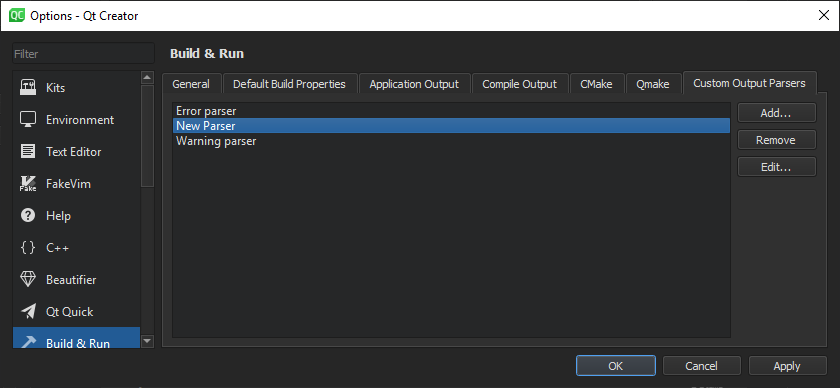Custom output parsers scan command line output for error and warning patterns that you specify and create entries for found patterns in the
Issues
output pane.
To view or add custom output parsers, select
工具
>
Options
>
Build & Run
>
Custom Output Parsers
.

To edit the settings of a custom output parser, select it in the list, and then select
Edit
.
To remove the selected parser, select
移除
.
You can activate custom output parsers in the
Custom Output Parsers
章节的
构建
and
运行
settings, as well as in the
custom compiler settings
.
Specifying Settings for Custom Output Parsers

A custom output parser enables you to capture errors and warnings separately, according to the settings you specify in the
Error
and
警告
tab.
To create a custom output parser:
-
选择
工具
>
Options
>
Build & Run
>
Custom Output Parsers
>
Add
.
-
在
Error message capture pattern
field, specify a regular expression to define what is an error. The custom parser matches the compile output line by line against the regular expression and displays errors in the
Issues
output pane. Create regular expression groups that contain the file name, line number and error message.
-
在
Capture Positions
field, map the regular expression groups to
File name
,
Line number
,和
Message
.
-
在
Capture Output Channels
field, specify whether messages from standard output, standard error, or both channels should be captured.
-
在
测试
group, you can test how the message that you enter in the
Error message
field is matched when using the current settings.
-
选择
OK
to add the parser to the list of parsers and return to the
Custom Output Parsers
tab.
-
Double-click the parser name to change it to something more descriptive than the default value.
Activating Custom Output Parsers

To activate a custom output parser in the
构建
or
运行
settings of a project:
-
在
Custom Output Parsers
section, select
细节
.
-
Select custom parsers to activate them for building or running the project.


